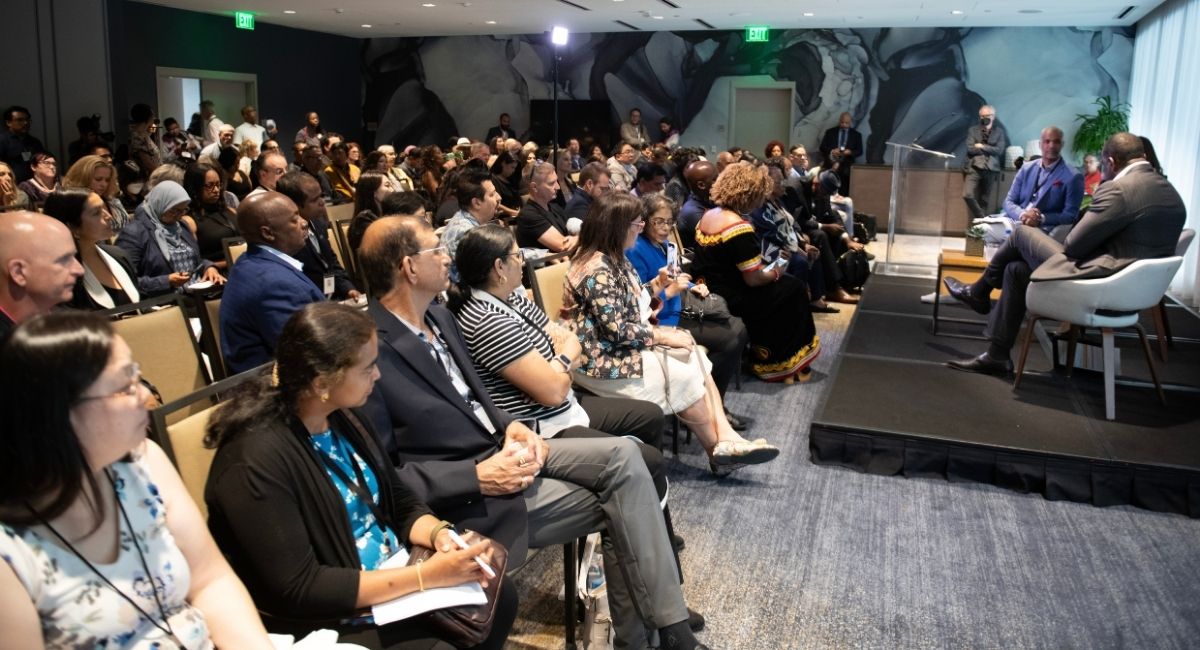Above: Ethnic media journalists, editors and publishers attend one of several plenary sessions featuring Transportation Secretary Toks Omishakin and Government Operations Secretary Amy Tong. (Credit: Robert Maryland/California Black Media.)
Ethnic media have long complained about the vast information gap separating them and their audiences from the halls of power in the State Capitol.
Not anymore.
Invited to the first ever conference for ethnic media to meet the leaders and decision makers of Sacramento, policy makers and elected officials accepted with enthusiasm. And so did some 150 ethnic media practitioners from as far north as Humboldt and as far south as Calexico, joined by dozens of comms specialists, journalism school faculty, and CBO representatives.
The event, held at the Kimpton Sawyer Hotel in Sacramento on Aug. 31, opened with a networking luncheon headlining secretary of State Shirley Weber and US Census Director Rob Santos; plenary sessions with leaders of top state agencies; a reporter’s roundtable on how to cover community taboos, and an ethnic media awards ceremony. It counted close to 350 attendees.
“I’m excited to participate in this ground-breaking event and share what we learned from our communication campaigns, including the 2020 Census and our pandemic response, and the important role that ethnic media played,” Maricela Rodriguez, senior advisor for Civic Engagement and Strategic Partnerships in the governor’s office, emailed in accepting her invitation to speak and encouraging others in state government to attend.
Rodriguez was the opening speaker at the first two plenary sessions for leaders of five state agencies – both filled to capacity by ethnic media, despite being off the record to ensure a candid exchange.
“This is an amazing event involving hundreds of people who came for a symposium for ethnic media and for agencies contributing to a variety of programs at the state level,” remarked Chris Holben, CEO of Runyon Salzman, looking around as he arrived for the opening lunch. Holben was one of five communications champions recognized for being models of how to work with ethnic media.
Opening doors
Diana Ding, founder and director of Ding Ding TV serving AAPI audiences in the South Bay, moderated the opening plenary session which featured Maricela Rodriguez, Michelle Baass, director of California’s Department of Health Care Services (DHCS), and Susan DeMarois, director of the California Department of Aging. Speakers shared their communication priorities on their most pressing concerns – extreme weather, health care access for MediCal recipients and the challenges of agism in an aging state.
“What struck me was how sincere these decision makers were in talking to us, and how willing they are to open the door,” remarked Ding. “I think they understand that just like CBOs providing direct services, ethnic media are also service providers – we educate the public about what the government is doing and what their resources are.”
Ding says the aging population “represents a huge opportunity ethnic media haven’t focused enough on. Government agencies like CDA and DHCS are providing great resources that AAPI audiences like mine don’t know are there. We need to be the missing link.”
Fatmeh Bakhit, founder and publisher of the Arabic language Al Enteshar, also said the issue of aging was front and center for Arab Americans. “This is the first time we get to hear from and meet with public officials, face to face. Each one was important, but it was all of them together that mattered.”
Bakhit praised Census Director Rob Santos for speaking from the heart, recognizing all communities as equal.
“It was great to build closer relations between minority communities and all levels of government,” said Charles Ding, veteran reporter for the Chinese-language World Journal and winner for Breaking News in in-language print media.
He pointed to Transportation Secretary Toks Omishakin and Government Operations Secretary Amy Tong, who spoke on broad band access, high speed rail and equity in government contracts, among other issues. “Usually, it’s not easy for us to interview them much less have them speak to us directly.”
‘Engaging with us matters’
“To me what was most illuminating were the off-the-record sessions with the decision makers. They showed us that they are listening and that engaging with us matters. They know we are channeling our communities,” said Pamela Anchang, publisher of Immigrant Magazine serving predominantly African diaspora members.
“They see we are building a collective voice and that there is strength in our union,” added her husband and co-publisher, Charles Anchang.
“Kudos to EMS and CBM,” said Francis Espiritu of Philippine News Today, after attending the first two sessions. “It’s not easy to bring these groups together…you hit a home run.”
Espiritu said he appreciated “the opportunity to pose no-filter questions regarding the budget process, and how officials make decisions on how to spend outreach funds.” He also noted the breakfast meeting with several elected officials held the morning after to talk about how to navigate Sacramento’s halls of power. Now, he stressed, “we have to be more proactive when it comes to advocating for more support from and access to officials.”
Check out the Schedule of Events for more information on the day’s events.



